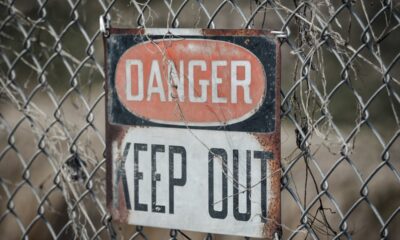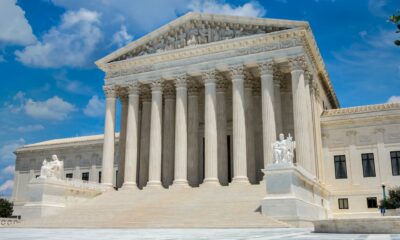Latest News
January 1, Scientist Sound Alarm After Carcinogen Found In Tap Water
For many years, tens of thousands of residents in northwest Seminole County, Lake Mary, and Sanford have unknowingly consumed water contaminated with a toxic industrial chemical. The Orlando Sentinel has discovered that the water these communities have been drinking contains varying concentrations of 1,4-dioxane, a chemical deemed likely to cause liver and kidney cancer and other illnesses by the U.S. Environmental Protection Agency.
This contaminant of “emerging” concern is so obscure that even utility managers in the county were not aware of its presence until recently. Some were only informed by the Sentinel in the past few months.
The 1,4-dioxane pollution has seeped hundreds of feet underground into the Floridan Aquifer, the region’s source of drinking water. The contamination has spread across a few square miles where the utilities of Lake Mary, Sanford, and Seminole County have wells pumping up millions of gallons, according to various investigations.
“Health research on the chemical in drinking water is sparse and dated. Voluntary guidelines for 1,4-dioxane concentrations range widely among states and countries, underscoring enormous and unsettling uncertainty about its potential harm,” the Sentinel reports.
Public utilities would never willingly allow a suspected carcinogen of any amount in the drinking water they supply to homes, schools, and businesses. Many officials of Lake Mary, Sanford, and Seminole County have expressed this sentiment.
Vasilis Vasiliou, the scientist leading a major, multiyear, and federally funded investigation of 1,4-dioxane health risks at Yale University, has also expressed caution. His team will research potential harm to people from chronic exposures to the chemical in tap water. The study began last year and is set to conclude in 2027. Previous studies were conducted with lab animals and did not include humans.
Despite the presence of 1,4-dioxane in the drinking water of Seminole County and two of its major cities, this information has not been previously provided by the media or publicly disclosed in a comprehensive or easily understandable manner by state authorities or local government and utility officials.
The discovery of 1,4-dioxane in Seminole County drinking water and the subsequent responses epitomize a national challenge: there are hundreds of poorly known contaminants infiltrating air, water, and food. Even as scientists are able to measure their tiniest quantities, these chemicals remain largely unregulated and unwatched.
The affected population in Seminole County spans a wide demographic range. It includes poor, Black neighborhoods in Sanford, upscale communities in the county such as Heathrow, and Lake Mary’s large employment centers such as Verizon and Deloitte.
Upon learning about a probable carcinogen in their tap water a decade ago, the three local utilities responded differently in attitudes and actions. Lake Mary, burdened with the highest concentration of contamination, was able to start up a high-tech treatment plant two years ago to remove nearly all of the chemical. Seminole County and Sanford reduced concentrations by shutting down the most contaminated wells.
The 1,4-dioxane contaminating drinking water in Seminole County has been linked to a storied, but long-shuttered factory between Interstate 4 and Rinehart Road in west Lake Mary. Built in the late 1960s by General Dynamics for its subsidiary Stromberg-Carlson, the factory went through a series of owners as it manufactured components for telephone systems.
By the late 1970s, it had 2,000 workers, sales of $80 million annually, and respectable wages from a yearly payroll of $30 million. It was a cornerstone of Seminole County’s economy and among the 30 largest employers in Central Florida.
In the early 2000s, the factory had been owned for more than a decade by the German industrial engineering giant Siemens and was near the end of its 35-year run: product sales were declining, layoffs were mounting, and evidence of an environmental disaster was sharpening.
In 2001, the city of Lake Mary found that factory chemicals had migrated deeply underground to infiltrate a newly drilled water well. But 1,4 dioxane, which was not a federally regulated chemical, was not among those for which the city tested.
With the factory’s closing in 2003, workers were alleging in lawsuits they had been exposed while on the job to toxic chemicals that caused their cancers and other illnesses.
The lawsuits and investigations by Siemens and state officials of the water well and the plant site zeroed in on chemicals called chlorinated solvents used to degrease and clean manufactured components.
Two at the factory included trichloroethylene, or TCE, and 1,1,1-Trichloroethane, or TCA, which are regulated for their concentrations in drinking water.
Also documented by the Florida Department of Environmental Protection in 2001 at the Siemens plant among the stew of toxic pollution in soil and underlying aquifer waters was 1,4-dioxane. It also is a solvent but had a supporting role – it was added to TCA solvent to prevent it from damaging electronic components.
Despite at the time a growing number of research warnings about 1,4-dioxane and incidents with the chemical elsewhere, its presence at the hazardous pollution site in Seminole County drew little concern or further investigation for its potential to infiltrate drinking water, according to environmental investigations by Siemens and the state at the time.
With the state’s Siemens plant site investigation still gaining notoriety in 2003, a Department of Environmental Protection spokesperson, Dave Herbster, told media there was no threat to drinking-water supplies.
Despite its detection at the Siemens site more than a decade earlier, 1,4-dioxane in Lake Mary, Sanford, and Seminole County drinking water would not be discovered until 2013 as a result of the U. S. Environmental Protection Agency ordering utilities nationwide to perform one-time sampling for that chemical and others for research purposes.
Lake Mary, Sanford, and Seminole County found 1,4-dioxane levels exceeding federal guidelines. Their officials have said they have no clue how far back and at what concentrations – extreme or minute – 1,4-dioxane was in their drinking water prior to its detection in 2013 by EPA-mandated testing and prior to 2001 when it was first documented at the Siemens plant site.
Thomas Mohr, a California-based expert on 1,4-dioxane and related chemicals and the lead writer of a comprehensive technical book on the chemical, said with no regulations for 1,4-dioxane in drinking water and so much unknown about its effects on people, utilities are in a tough place for reacting to the chemical.
“We simply don’t understand the cumulative and interactive effects of multiple toxins at multiple life stages, multiple routes of exposure, and how they all add up over the course of our lifetime,” Mohr said. “So if we see a known threat, whether it’s arsenic or 1,4-dioxane or PFAS, if there’s an opportunity to intervene and prevent consumption of that chemical, I think it’s incumbent upon drinking water utilities to do what they can to intervene and remove it.”
Options are limited for a homeowner or business worried about the chemical in their tap water: buy bottled water or install in-home treatment equipment.
The only practical way for a homeowner to remove 1,4-dioxane from tap water is with a reverse osmosis system that can cost hundreds of dollars for a kitchen unit and thousands for a whole-house system.
The most effective treatment technologies and equipment must be installed at water utility plants, according to the Environmental Working Group, a national advocate for safe drinking water policies and practices. “If you are concerned about 1,4-dioxane in your water, urge your utility to install effective treatment technologies,” the group recommends.
During most of the past decade, Seminole County, Sanford, and Lake Mary have faced different challenges, deadlines, and solutions in seeking to reduce concentrations of 1,4-dioxane in drinking water.
Lake Mary drinking water had the highest concentrations for many years but the city finally started up one of the most advanced water treatment plants in the state in 2021.
The facility cost an estimated $40 million – an extraordinary sum for treating water pumped out of the Floridan Aquifer – and was paid for “voluntarily” by owners of the telephone equipment factory as part of a 2017 agreement with the city and state.
The owners did not admit liability, but said Lake Mary water contamination “may have been the result” of the Siemens factory.
The Lake Mary water treatment plant, equipped with hydrogen peroxide, ultraviolet light, and carbon filtration, according to the city’s detailed description of its “advanced oxidation” technology, was designed to strip away all but trace amounts of 1,4-dioxane.
1,4-dioxane concentrations in drinking water of Sanford and northwest Seminole have been held to about half of the state and federal advisory concentration, according to frequent tests, largely by reducing the use of the wells that are the most contaminated with the chemical.
But because the chemical is not regulated for drinking water, the three water providers have been under no obligation to keep their customers informed beyond brief references to 1,4-dioxane included in their annual water reports of 2015 and 2016.
From then on, as the cities and county realized they had a serious problem, public disclosure vanished.
Detailed awareness of the 1,4-dioxane contamination, in a language of acronyms, hydrogeology, and chemistry, remained the domain of a small cadre of specialty lawyers and consultants, state authorities, and utility leaders.
George Sellery, who lives in the Lake Forest neighborhood, west of Sanford, is one of many random residents of Seminole County sought out by the Sentinel to learn what they knew of 1,4-dioxane in their water. He was surprised when told of the contamination.
“I trust Seminole County when they say the levels are not that high, and that it doesn’t meet the threshold,” Sellery said, referring to the state and federal health advisory limit. “But they still need to be transparent. There could be some people who may be undergoing chemotherapy, or having other health issues, and they should know about it.”
“That level of dioxane may not be an issue for you or I. But someone with a thyroid condition, or sickle cell anemia or cancer, their bodies may react differently. Just by letting them know, they may switch to bottled water,” Sellery said.
Lee Constantine, a Seminole County Commissioner who has prioritized water issues, was left speechless during an interview in June when told of the widespread presence of the chemical in the county’s public water systems.
He had never heard of 1,4-dioxane, much less that it had infiltrated tap water provided to as many as 100,000 people living in his county. Constantine soon learned that neither had senior county executives.
“I’ve had some sleepless nights over this,” Constantine said a few days later. “I was in the dark about it.”
Considering the number of people affected, the span of time involved, and the health hazards of 1,4-dioxane, it may be the Orlando region’s most worrisome instance of contaminated drinking water, a prospect the Florida Department of Environmental Protection has declined repeatedly to address.
Lake Mary supplies water to more than 17,000 residents and Sanford’s water system serves more than 65,000 people.
Seminole County officials don’t know the population of their northwest water service area. Extending along the west side of Interstate 4, geographically it is Seminole’s largest water service area and has 9,215 residential and commercial customers.
For nearly a decade, the wells and tap waters of Sanford, Lake Mary, and Seminole County have been tested frequently, providing a record of the concentrations of 1,4-dioxane reaching their customers.
With that data, residents and workers in Lake Mary, Sanford, and northwest Seminole County could turn out to be the equivalent of laboratory subjects and help the federal government in further consideration of regulating 1,4-dioxane.
With a $7.5 million federal grant tied to the EPA’s Superfund pollution program, Yale University’s study of 1,4-dioxane is to run at least through 2027 in pursuing a more direct and thorough understanding of human health effects.
Vasiliou, the director, said studying environmental contaminants like 1,4-dioxane is key to unraveling increased rates of cancer worldwide.
“What is really worrying in our society is the major increase that we see in the world of what we call early onset of cancer,” Vasiliou said.
“You see young people having liver cancer or colon cancer, which cannot be really explained from genetic mutations,” Vasiliou said. “So this is most likely a result from exposure.”
Still designing the Yale research, Vasiliou said Seminole County is a potential case study, although that would depend largely on request and support from people in the community.
Yale researchers are in the process of engaging residents of Long Island, New York, a community with 1,4-dioxane in its drinking water, to assess the effects of long-term exposure.
The last major studies on the health effects of 1,4-dioxane were in the 1960s and 1970s, followed by two in Japan in the late 2000s that have been challenged for whether their procedures were appropriate.
The studies involved exposing lab mice, rats, and guinea pigs to increasing amounts of 1,4-dioxane until they became ill.
While 1,4-dioxane is carcinogenic to animals, also causing nasal and mammary gland cancers, scientists don’t know how the chemical triggers illness.
The mechanism appears to be different from other well-known liver carcinogens, Vasiliou said.
Vasiliou hopes that he and his team can collect enough evidence through animal and epidemiological studies to propose a legal cap on 1,4-dioxane levels in drinking water, in the environment, and in consumer products.
He knows setting an enforceable limit on concentrations will be a drawn-out process that may not succeed.
In 2012, the EPA adopted a recommended, unenforceable limit for 1,4-dioxane in drinking water. It is tiny.
The EPA’s recommended limit is a fraction of 1 part per 1 billion parts of water, or 0.35 parts per billion.
A concentration of 0.35 parts per billion is equivalent to an 8-ounce cup of 1,4-dioxane mixed into 150 million gallons of water.
Known peak parts per billion a decade ago were 1.3 in Lake Mary, 0.41 in Sanford, and 0.58 in the county.
The EPA limit is based on a risk level of one cancer diagnosis per million people.
In 2013, the state of Florida adopted the EPA’s guideline, also as an unenforceable limit of 1,4-dioxane in drinking water.
Florida’s limit is the same as Colorado’s and slightly more than Massachusetts’ limit. Mississippi’s is 6 parts per billion, while Kansas has a guideline of 8.5 parts per billion.
Mohr, the California-based expert, thinks the wide range of 1,4-dioxane guidelines for drinking water in other states and countries is due partly to governments selecting different studies to rely on.
Another factor, Mohr said, is the degree of risk deemed appropriate: whether it’s acceptable for cancer to develop in one person per 10,000 people, 100,000 people, or 1 million.
Also a factor that varies is the timescale of human exposure to the chemical that authorities select, ranging from 30 years to 70 years.
Still another consideration, Mohr suspects, is to what degree a state’s politics and policies are influenced by chemical manufacturers and users.
The Citizens Campaign for the Environment, a group based in New York and focused on getting 1,4-dioxane out of water and consumer products, said the EPA is long overdue for moving beyond unenforceable guidelines and establishing legal standards for the chemical.
“The EPA has been all too silent on 1,4-dioxane and they need to step it up,” said Adrienne Esposito, the group’s executive director. “Dioxane has become so abundant, and so frequently found in our everyday lives, that it really deserves to be highly regulated.”
For those who fear they have been exposed, there’s no way to know when or if health effects may occur, according to Yale’s scientists.
1,4-dioxane rinses out of a human body quickly and doesn’t accumulate.
After exposure to 1,4-dioxane or any carcinogen, any damage is not reversible, said Paul Anastas, a Yale professor who directs the school’s Center for Green Chemistry and Green Engineering.
“There’s no way that I know of to unring that bell,” Anastas said.
A vexing question for researchers is how 1,4-dioxane may interact with other contaminants that people ingest or encounter in their lives – especially at chronic and low levels.
“What we don’t know about the interactions of these chemicals, and whether or not the health effects are additive, or synergistic — which means a multiplier — could fill volumes,” Anastas said. “We know next to nothing about the toxic effects of mixtures.”
Researchers recognize and health advocates fear that 1,4-dioxane is everywhere.
Traces and higher concentrations occur incidentally or as additives in plastics manufacturing, dyes, greases, deodorants, shampoo, cosmetics, toothpaste, food crop pesticides, and more.
“It’s not something to trivialize, because we don’t know,” said Roger Rayle, chair of the Coalition for Action on Remediation of Dioxane, a group responding to contamination in Michigan. He worries 1,4-dioxane cancer risks are higher than EPA’s estimate.
“We lack data on long-term effects of human exposure to dioxane,” Rayle said. “We don’t want to be the guinea pigs.”
If you have pertinent information about the 1,4-d
Why It Matters (op-ed)
The discovery of 1,4-dioxane in Seminole County drinking water is another example of the government’s failure to protect its citizens. Tens of thousands of residents unknowingly consumed toxic, cancer-causing chemicals for years, a result of negligence and lack of transparency by authorities.
The situation epitomizes the national challenge of hundreds of poorly known contaminants infiltrating our air, water, and food. It’s high time we demand stricter regulations and increased vigilance from our government to ensure the safety of our resources. The health and well-being of our communities are at stake, and we can no longer afford to wait for future generations to pay the price.
As our loyal readers, we encourage you to share your thoughts and opinions on this issue. Let your voice be heard and join the discussion below.

-

 Entertainment4 months ago
Entertainment4 months ago‘He’s A Pr*ck And F*cking Hates Republicans’: Megyn Kelly Goes Off on Don Lemon
-

 Entertainment9 months ago
Entertainment9 months agoWhoopi Goldberg’s “Wildly Inappropriate” Commentary Forces “The View” into Unscheduled Commercial Break
-

 Entertainment8 months ago
Entertainment8 months agoLate Night Host is Getting Canceled After Staffers Speak Out
-

 Entertainment4 months ago
Entertainment4 months agoBeach Boys Founder Brian Wilson Announces Tragic News
-

 Featured9 months ago
Featured9 months agoUS Advises Citizens to Leave This Country ASAP
-

 Entertainment3 months ago
Entertainment3 months agoComedy Mourns Legend Richard Lewis: A Heartfelt Farewell
-

 Featured8 months ago
Featured8 months agoBenghazi Hero: Hillary Clinton is “One of the Most Disgusting Humans on Earth”
-

 Latest News3 months ago
Latest News3 months agoSupreme Court Gift: Trump’s Trial Delayed, Election Interference Allegations Linger

Dee
February 24, 2024 at 10:58 am
Horrifying didn’t know far more serious than we previou hrough under the Democrats controlled of United States for decades intensively manipulating our health of life with toxic in the waters supplied within the State’s of governance . Is time to change’s rightful reliable American servants to takeover for fixing our overall drinking waters systems in urgently !